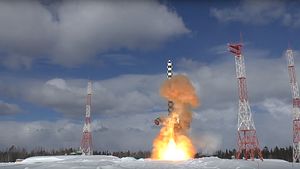Russia’s Strategic Rocket Force has conducted an ejection test of its most powerful new intercontinental-range ballistic missile (ICBM), the super-heavy thermonuclear-armed RS-28 Sarmat (NATO designation: SS-X-30 Satan 2) at the Plesetsk space center, located in Arkhangelsk Oblast, approximately 800 kilometers north of Moscow on the Russian Ministry of Defense (MoD) said in a statement today.
“The new heavy intercontinental ballistic missile underwent an ejection test at the Plesetsk state test cosmodrome,” a March 30 MoD statement reads. “The pre-flight preparations were carried out according to plan. During the test, the ICBM proved its specifications within pre-flight preparations and initial stage of the flight [sic].”
A video shows the RS-28, painted in black and white checkers (facilitate easier speed measurement), ejected from a missile silo, and then igniting its own engine. The MoD revealed no further details about the missile’s flight route.
Preparations for an ejection test, or pop-up launch test, tests the mechanism of a missile leaving its launch container or missile silo. The last ejection test took place in December 2017, which purportedly revealed several technical deficiencies with the silo-based launchers. A test of the Sarmat’s first stage engine, named PDU-99—most likely a modified version of the RD-274 liquid rocket engine used on the RS-36M2 Voyevoda (NATO designation: SS-18 Satan), occurred in August 2016.
The silo-based RS-28 is slated to replace all Soviet-era RS-36M2 ICBMs by the mid-2020s. “The RS-36s are expected to stay in service until at least 2024, but their service life may be extended up to 2027 depending on the RS-28 induction schedule,” I explained this month. As I reported yesterday, the first regiment of Russia’s Strategic Rocket Force is expected to deploy the new missile system in 2021.
However, the RS-28 program has encountered various delays and it is uncertain that the missile will be operational by 2021.
“The Sarmat can reportedly carry [around] 10 heavy lighter warheads. The new ICBM can allegedly also be fitted with a new [hypersonic boost-glide warhead], the YU-71, currently in development under the secret Project 4202,” I explained elsewhere. “(…) The YU-71 is a warhead purportedly capable of penetrating any Western missile defense system. (…) Each warhead [allegedly] has an explosive yield of up to 750 kilotons.”
According to Russian President Vladimir Putin, Russia’s new hypersonic boost-glide vehicle is already in serial production. The new warhead, dubbed Avangard (Vanguard in English), is expected to be ready for operational use as early as next year. As with the Sarmat RS-28, it appears likely that the induction date will be pushed back. One RS-28 will be able to carry three to five Avangard warheads.































